The Pediatric Measuring Devices Market is estimated to be valued at USD 1391.4 million in 2025 and is projected to reach USD 2119.7 million by 2035, registering a compound annual growth rate (CAGR) of 4.3% over the forecast period.
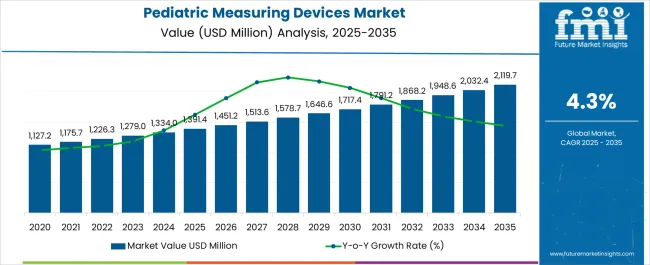
| Metric | Value |
|---|---|
| Pediatric Measuring Devices Market Estimated Value in (2025 E) | USD 1391.4 million |
| Pediatric Measuring Devices Market Forecast Value in (2035 F) | USD 2119.7 million |
| Forecast CAGR (2025 to 2035) | 4.3% |
The Pediatric Measuring Devices market is experiencing steady growth, driven by increasing demand for accurate and efficient measurement tools in pediatric healthcare settings. Rising awareness of child health monitoring, early diagnosis, and nutritional assessments is fueling adoption in hospitals, clinics, and research institutions. Technological advancements in electronic measurement devices, data integration, and mobile-enabled systems are improving precision, reducing errors, and enabling real-time monitoring of pediatric growth parameters.
The integration of user-friendly interfaces and digital recording capabilities supports healthcare professionals in capturing and tracking critical patient information efficiently. Growing investments in pediatric healthcare infrastructure, particularly in emerging markets, along with government initiatives for child health and nutrition monitoring, are further boosting market expansion.
The focus on portable, scalable, and versatile measurement solutions has encouraged the adoption of devices suitable for both clinical and home settings As healthcare providers increasingly prioritize accurate, standardized, and automated measurement solutions, the Pediatric Measuring Devices market is expected to maintain consistent growth over the coming decade.
The pediatric measuring devices market is segmented by device type, technology type, configuration type, end user type, and geographic regions. By device type, pediatric measuring devices market is divided into Infantometer, Mobile Measuring Mat, Height Measuring Rods, Head Circumference Measuring Tape, Stadiometer, and Others. In terms of technology type, pediatric measuring devices market is classified into Electronic Pediatric Measuring Device and Mechanical Pediatric Measuring Device. Based on configuration type, pediatric measuring devices market is segmented into Mobile, Bench-Top, Wall-Mounted, and Floor-Standing. By end user type, pediatric measuring devices market is segmented into Hospitals, Clinics, and Others. Regionally, the pediatric measuring devices industry is classified into North America, Latin America, Western Europe, Eastern Europe, Balkan & Baltic Countries, Russia & Belarus, Central Asia, East Asia, South Asia & Pacific, and the Middle East & Africa.
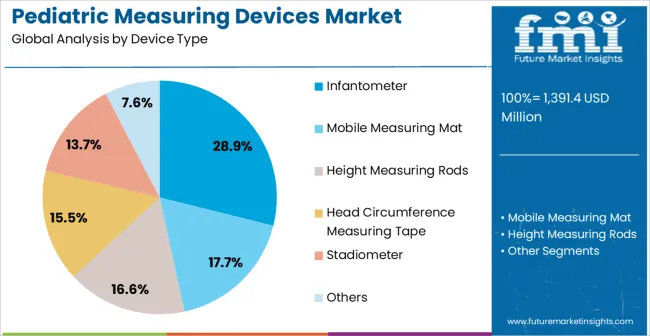
The infantometer device type segment is projected to hold 28.9% of the market revenue in 2025, establishing it as the leading device type. Its prominence is being driven by the critical need to measure infant length accurately for clinical assessment, growth monitoring, and early detection of developmental anomalies. Infantometers provide precise readings and are designed for safe and comfortable use in hospital, clinic, and research environments.
The ability to deliver consistent, reliable measurements without complex calibration requirements has reinforced preference among healthcare providers. Integration with electronic data recording systems further enhances utility, enabling efficient tracking of pediatric growth over time.
Advances in design, safety features, and portability have expanded the applicability of infantometers beyond traditional hospital settings As pediatric healthcare continues to emphasize early intervention and standardized growth assessments, the infantometer segment is expected to maintain its leading position, driven by accuracy, reliability, and ease of use.
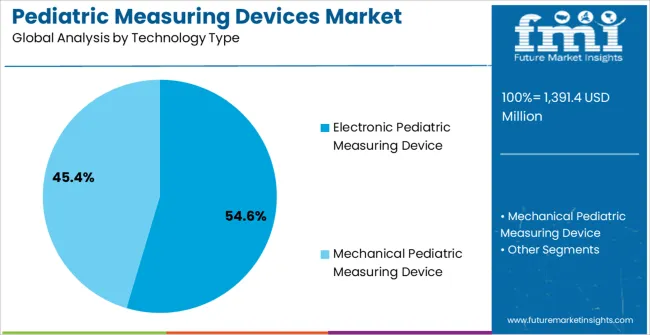
The electronic pediatric measuring device technology segment is anticipated to account for 54.6% of the market revenue in 2025, making it the leading technology type. Growth is being driven by the demand for precise, automated, and digitally integrated measurement tools that minimize human error and enhance data reliability. Electronic devices enable seamless recording, storage, and analysis of pediatric growth metrics, supporting clinical decision-making and long-term patient tracking.
Advancements in sensor technology, digital interfaces, and connectivity features have improved measurement speed, accuracy, and ease of use. The integration of electronic devices with hospital information systems allows real-time data access, trend analysis, and reporting, further strengthening adoption.
Increased focus on quality healthcare delivery, compliance with pediatric care standards, and the need for standardized measurement protocols are key factors supporting the growth of electronic measurement solutions As healthcare facilities continue to adopt digital solutions to improve patient outcomes and operational efficiency, the electronic pediatric measuring device segment is expected to remain the market leader.
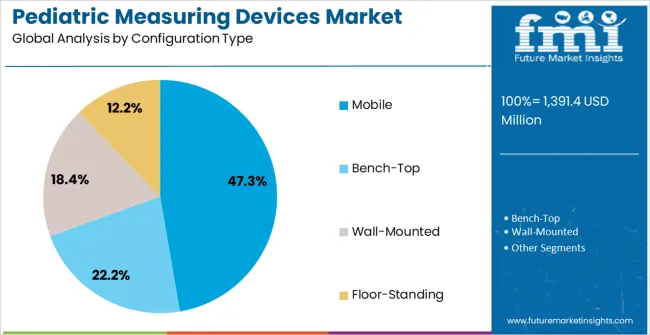
The mobile configuration type segment is projected to hold 47.3% of the market revenue in 2025, establishing it as the leading configuration. Its prominence is being driven by the growing need for portable, flexible, and easy-to-use measurement solutions that can be employed in clinical, home, and field settings. Mobile devices allow healthcare providers to conduct pediatric assessments with minimal space and infrastructure requirements, enhancing accessibility and convenience.
Integration with electronic recording systems and mobile applications enables real-time data capture, remote monitoring, and trend analysis, improving decision-making and patient care. The portability of mobile configurations supports outreach programs, community health initiatives, and home-based monitoring, broadening the use cases beyond traditional healthcare facilities.
Advances in battery life, ergonomic design, and user-friendly interfaces have further reinforced adoption As pediatric healthcare increasingly emphasizes accessibility, efficiency, and continuous monitoring, the mobile configuration segment is expected to maintain its leadership, supported by technological innovation and rising demand for versatile measurement solutions.
Pediatric measuring device is used to carry out health diagnosis of the infants and children below 18 years. These devices are intended to be used as treatment and care for infants. Pediatric measuring devices are specifically designed for children and proves to be a challenging task for manufacturers as infants and new born babies have a flexible body structure.
Pediatric measuring devices have vast application in hospitals, clinics, infants care center, and are used by doctors, pediatricians and other child specialists which increases the demand in pediatric measuring devices market. Various pediatric measuring devices are available in the market that are used to detect distinct disease conditions such as overweight, underweight, short stature, restricted growth.
Pediatric measuring devices are used to reassure the wellbeing of children by measuring, plotting and interpreting growth patterns in infants as well as toddlers. On the basis of device type, pediatric measuring devices are broadly categorized into five types including infantometer, mobile measuring mat, height measuring rods, head circumference measuring tape, stadiometer (infant measuring board).
These measuring devices is further categorized on the basis of technology that includes mechanical and electronic measuring devices for pediatrics. Pediatric measuring devices are also available in different configurations majorly including mobile, tabletop, wall-mounted, and floor-standing. These devices should be well calibrated before carrying out any measurements.
Specific regulations for using digital electronic scales and other measuring devices for infants have been made by the regional regulatory which is mandatory to be followed while using any of the pediatric measuring device. With the rising rate of child birth the demand for pediatric measuring devices is increasing and thus contribute majorly to the revenue generation in pediatric measuring devices market.
These Pediatric Measuring devices are broadly used to diagnose health conditions of infants and toddlers. Pediatric Measuring devices market on the other hand is gaining profit due to rising incidence of premature births coupled with introduction of innovative pediatric measuring devices in the market.
Birth deformities is one of the main reason which drives the sales of pediatric measuring devices. Increased technological innovations in the pediatric devices market tend to propel the growth of pediatric measuring devices market across the globe.
Pediatric Measuring devices also find increased application in disease areas including mainly including nephrology and hypertension. This is further anticipated to drive the demand for pediatric measuring devices and thereby increasing revenue generation in pediatric measuring devices market.
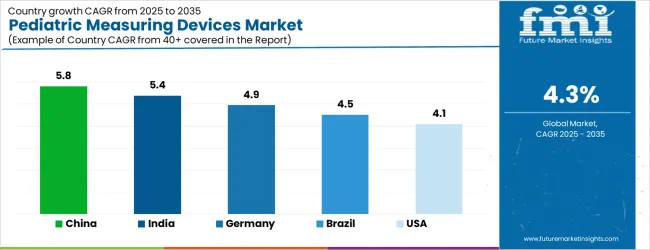
| Country | CAGR |
|---|---|
| China | 5.8% |
| India | 5.4% |
| Germany | 4.9% |
| Brazil | 4.5% |
| USA | 4.1% |
| UK | 3.7% |
| Japan | 3.2% |
The Pediatric Measuring Devices Market is expected to register a CAGR of 4.3% during the forecast period, exhibiting varied country level momentum. China leads with the highest CAGR of 5.8%, followed by India at 5.4%. Developed markets such as Germany, France, and the UK continue to expand steadily, while the USA is likely to grow at consistent rates. Japan posts the lowest CAGR at 3.2%, yet still underscores a broadly positive trajectory for the global Pediatric Measuring Devices Market. In 2024, Germany held a dominant revenue in the Western Europe market and is expected to grow with a CAGR of 4.9%. The USA Pediatric Measuring Devices Market is estimated to be valued at USD 476.4 million in 2025 and is anticipated to reach a valuation of USD 476.4 million by 2035. Sales are projected to rise at a CAGR of 0.0% over the forecast period between 2025 and 2035. While Japan and South Korea markets are estimated to be valued at USD 71.0 million and USD 46.7 million respectively in 2025.
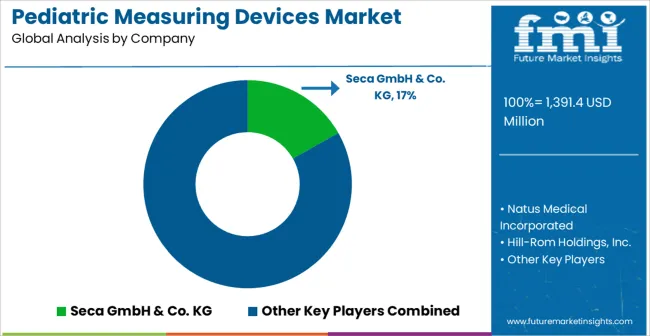
| Item | Value |
|---|---|
| Quantitative Units | USD 1391.4 Million |
| Device Type | Infantometer, Mobile Measuring Mat, Height Measuring Rods, Head Circumference Measuring Tape, Stadiometer, and Others |
| Technology Type | Electronic Pediatric Measuring Device and Mechanical Pediatric Measuring Device |
| Configuration Type | Mobile, Bench-Top, Wall-Mounted, and Floor-Standing |
| End User Type | Hospitals, Clinics, and Others |
| Regions Covered | North America, Europe, Asia-Pacific, Latin America, Middle East & Africa |
| Country Covered | United States, Canada, Germany, France, United Kingdom, China, Japan, India, Brazil, South Africa |
| Key Companies Profiled | Seca GmbH & Co. KG, Natus Medical Incorporated, Hill-Rom Holdings, Inc., Medtronic plc, GE Healthcare, Philips Healthcare, Welch Allyn, Inc., Masimo Corporation, Drägerwerk AG & Co. KGaA, Invacare Corporation, Smiths Medical, Cardinal Health, Inc., and Omron Healthcare, Inc. |
The global pediatric measuring devices market is estimated to be valued at USD 1,391.4 million in 2025.
The market size for the pediatric measuring devices market is projected to reach USD 2,119.7 million by 2035.
The pediatric measuring devices market is expected to grow at a 4.3% CAGR between 2025 and 2035.
The key product types in pediatric measuring devices market are infantometer, mobile measuring mat, height measuring rods, head circumference measuring tape, stadiometer and others.
In terms of technology type, electronic pediatric measuring device segment to command 54.6% share in the pediatric measuring devices market in 2025.






Our Research Products

The "Full Research Suite" delivers actionable market intel, deep dives on markets or technologies, so clients act faster, cut risk, and unlock growth.

The Leaderboard benchmarks and ranks top vendors, classifying them as Established Leaders, Leading Challengers, or Disruptors & Challengers.

Locates where complements amplify value and substitutes erode it, forecasting net impact by horizon

We deliver granular, decision-grade intel: market sizing, 5-year forecasts, pricing, adoption, usage, revenue, and operational KPIs—plus competitor tracking, regulation, and value chains—across 60 countries broadly.

Spot the shifts before they hit your P&L. We track inflection points, adoption curves, pricing moves, and ecosystem plays to show where demand is heading, why it is changing, and what to do next across high-growth markets and disruptive tech

Real-time reads of user behavior. We track shifting priorities, perceptions of today’s and next-gen services, and provider experience, then pace how fast tech moves from trial to adoption, blending buyer, consumer, and channel inputs with social signals (#WhySwitch, #UX).

Partner with our analyst team to build a custom report designed around your business priorities. From analysing market trends to assessing competitors or crafting bespoke datasets, we tailor insights to your needs.
Supplier Intelligence
Discovery & Profiling
Capacity & Footprint
Performance & Risk
Compliance & Governance
Commercial Readiness
Who Supplies Whom
Scorecards & Shortlists
Playbooks & Docs
Category Intelligence
Definition & Scope
Demand & Use Cases
Cost Drivers
Market Structure
Supply Chain Map
Trade & Policy
Operating Norms
Deliverables
Buyer Intelligence
Account Basics
Spend & Scope
Procurement Model
Vendor Requirements
Terms & Policies
Entry Strategy
Pain Points & Triggers
Outputs
Pricing Analysis
Benchmarks
Trends
Should-Cost
Indexation
Landed Cost
Commercial Terms
Deliverables
Brand Analysis
Positioning & Value Prop
Share & Presence
Customer Evidence
Go-to-Market
Digital & Reputation
Compliance & Trust
KPIs & Gaps
Outputs
Full Research Suite comprises of:
Market outlook & trends analysis
Interviews & case studies
Strategic recommendations
Vendor profiles & capabilities analysis
5-year forecasts
8 regions and 60+ country-level data splits
Market segment data splits
12 months of continuous data updates
DELIVERED AS:
PDF EXCEL ONLINE
Fuel Measuring Devices Market
Pediatric Dental Market Size and Share Forecast Outlook 2025 to 2035
Pediatric Supplement Market - Size, Share, and Forecast Outlook 2025 to 2035
Pediatric Tube Feeding Market Analysis by Formula Type, Feeding Method, Form, Specific Needs, Dietary Preference, Age, Distribution Channel and Region Through 2035
Pediatric Home Healthcare Market - Growth & Demand Trends 2025 to 2035
Pediatric Obesity Management Market Analysis by Drug Class, Route of Administration, Distribution Channel and Region: Forecast for 2025 to 2035
Pediatric Heart Valve Repair and Replacement Analysis by Product, Induction, End Users and Region-2025 to 2035
Pediatric Nutrition Market – Growth, Demand & Child Health Trends
Global Pediatric Diabetes Therapeutic Market Analysis – Size, Share & Forecast 2024-2034
Global Pediatric Clinical Trial Market Analysis – Size, Share & Forecast 2024-2034
Pediatric Vitrectomy Market
Pediatric Nasal Cannula Market
Air Measuring Equipment Market Size and Share Forecast Outlook 2025 to 2035
FBAR Devices Market
Laser Measuring Instrument Market Size and Share Forecast Outlook 2025 to 2035
Snare devices Market
Level Measuring Instrument Market
C-Arms Devices Market Size and Share Forecast Outlook 2025 to 2035
Timing Devices Market Analysis - Size, Growth, & Forecast Outlook 2025 to 2035
Spinal Devices Market Size and Share Forecast Outlook 2025 to 2035

Thank you!
You will receive an email from our Business Development Manager. Please be sure to check your SPAM/JUNK folder too.
Chat With
MaRIA